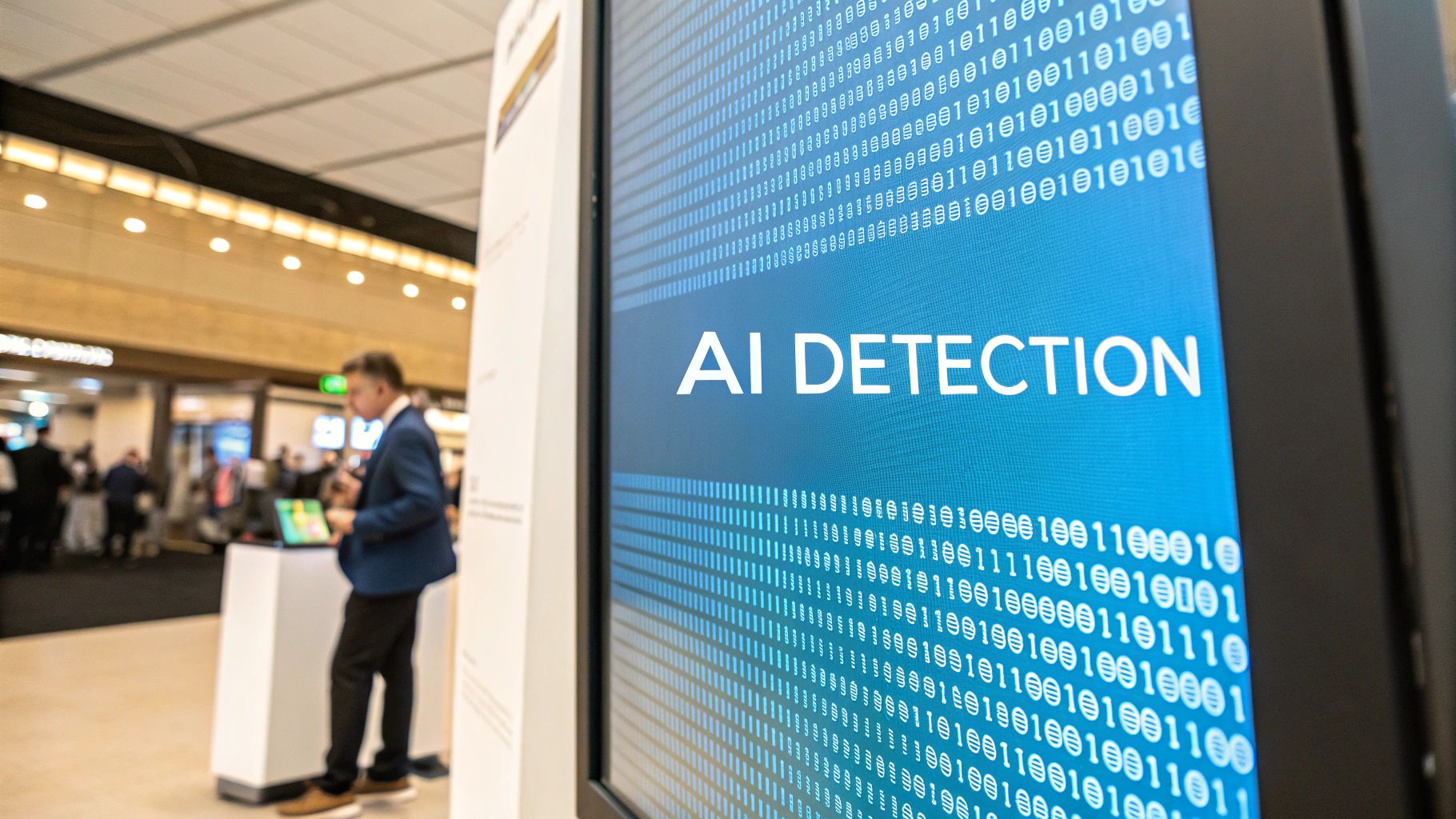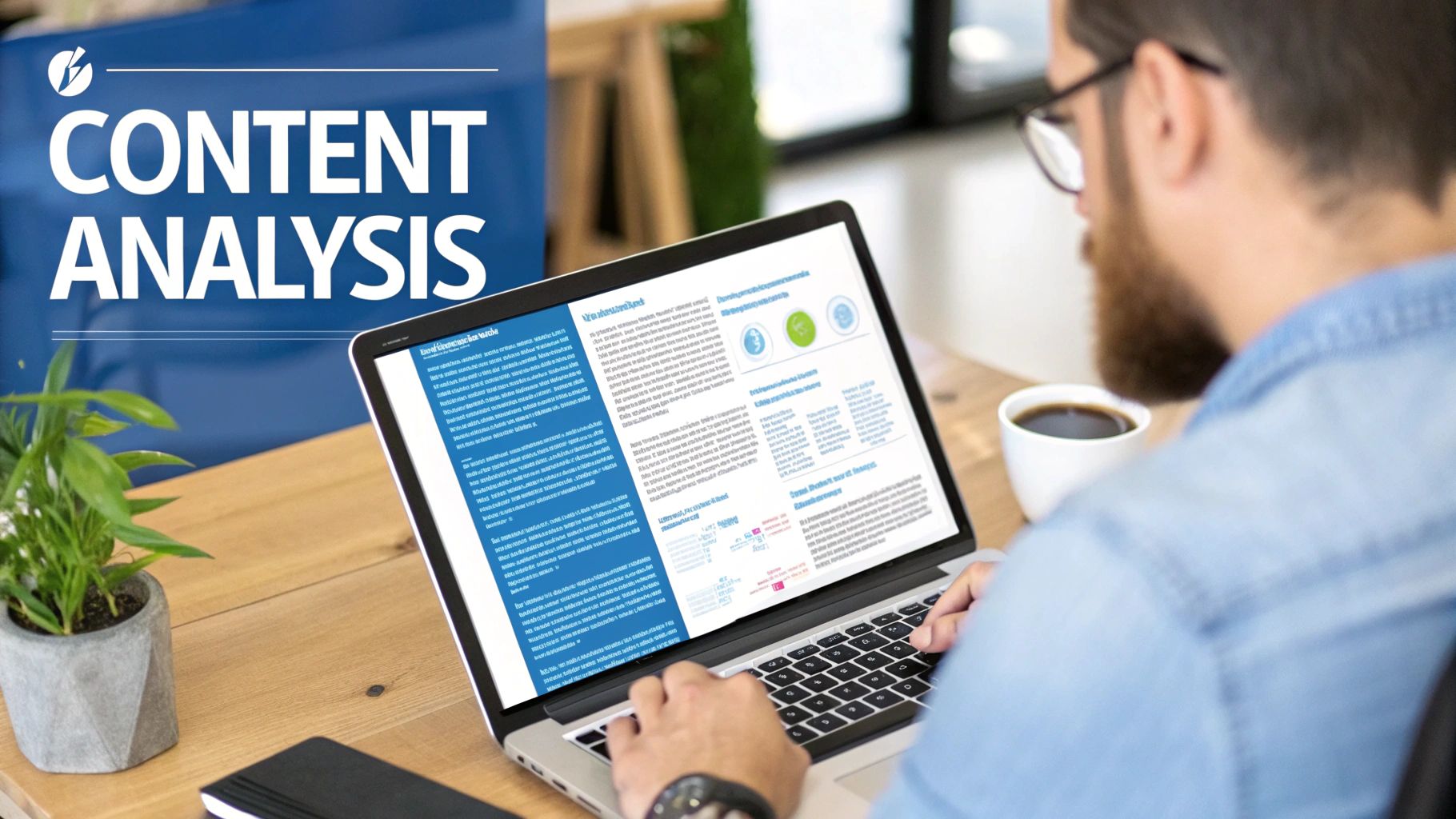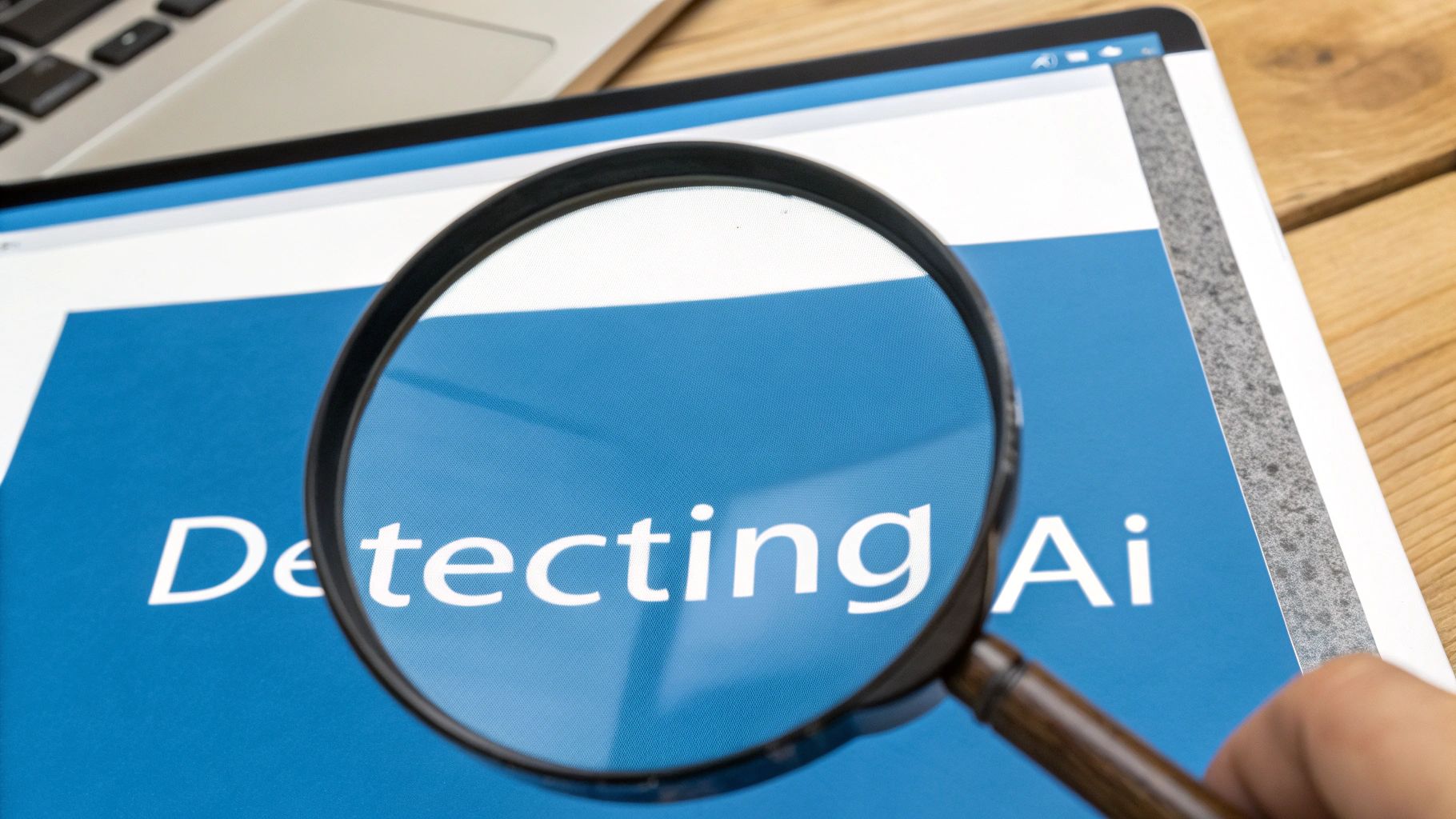I have focused on natural flow between ideas while maintaining all key technical requirements and formatting:
Understanding How AI Content Detection Really Works

When examining a piece of text, AI content detectors act like digital forensics experts, searching for subtle patterns and clues that reveal whether a human or AI created the writing. These tools go far beyond simple plagiarism checking – they analyze the fundamental characteristics and structure of the text itself.
Decoding the Secrets of AI-Generated Text
While AI writing tools can produce impressive content, they leave behind distinctive patterns in their work. Just as each person has a unique writing style, AI generators have their own telltale signatures. For example, AI text often follows predictable sentence patterns and lacks the natural variation found in human writing.
The limitations of AI become apparent when dealing with complex ideas or creative expression. Though grammatically sound, AI-generated content frequently misses the depth and originality that stems from human understanding and experiences. This happens because AI creates text by calculating statistical probabilities of word sequences rather than truly grasping meaning and context.
How AI Content Detectors Analyze Text
To spot AI-written content, detection tools use several key techniques. Classifiers learn to categorize text by studying vast datasets of both human and AI writing samples. Embeddings create mathematical representations of words that reveal how AI and humans use language differently.
Perplexity measures help identify AI text by analyzing how predictable the writing is – human authors tend to be less predictable. Similarly, burstiness examines variety in sentence structure, with AI typically showing less natural variation than humans. Modern detection tools have reached impressive accuracy levels – for instance, Originality.ai's detector achieves up to 98% accuracy with less than 1% false positives, making it especially valuable for academic integrity.
The Importance of Human Oversight
Despite their growing sophistication, AI detectors aren't perfect tools. Human review remains essential to properly interpret results and make final judgments about content authenticity. Think of these detectors as helpful assistants that support, but don't replace, human expertise in content verification. Moving forward, the most effective approach will likely combine advanced AI detection capabilities with experienced human oversight.
Choosing the Right Detection Tools for Your Needs

As AI writing tools become more common, reliable detection tools are increasingly important for verifying content authenticity and academic honesty. Finding the right tool means carefully assessing your specific needs and testing how different options perform in real-world use.
Key Features to Consider in an AI Content Detector
The best AI detectors combine several essential capabilities that make them practical and effective. When evaluating tools, focus on core features that directly impact your workflow.
Key factors to look for include:
- High accuracy in identifying both AI and human content
- Quick processing for handling text efficiently
- Simple integration with your existing tools and systems
- Clear reporting that highlights potential AI text
- Responsive support to help resolve any issues
You can learn more about getting started with content checking at SmartStudi's content checking guide.
Evaluating AI Content Detector Performance
Real-world testing shows significant variation in how well different detectors work. Research indicates that accuracy rates range from just 19.8% to 98.4% depending on the specific AI models and test data used. This wide spread makes it important to look at multiple performance metrics rather than relying on a single measure. For more details on how these tools function, check out this detailed analysis of AI detectors.
Comparing Top AI Content Detectors
This comparison helps illustrate key differences between leading detection tools:
| Feature | Detector A | Detector B | Detector C |
|---|---|---|---|
| Accuracy | High | Medium | High |
| Speed | Fast | Medium | Slow |
| Integration | LMS, APIs | LMS | APIs |
| Reporting | Detailed | Summary | Basic |
| Price | Premium | Free | Mid-Range |
Taking time to evaluate features, test performance, and compare options helps ensure you select a detector that meets your needs. A systematic approach leads to more reliable content verification and helps maintain high standards for original writing.
Making Sense of Detection Results
Understanding AI content detector results takes more than just looking at a simple score. While these tools help identify AI-written text, getting meaningful insights requires careful analysis and evaluation of multiple factors.
Understanding Detection Scores and Confidence Intervals
AI detectors typically show a percentage indicating how likely text was AI-generated. However, these scores come with confidence intervals – similar to weather forecasts, there's always some uncertainty. For example, a 90% AI probability suggests very likely AI involvement, but isn't definitive proof.
The writing style and format also affect detection scores significantly. Technical or academic writing may register as more "AI-like" even when human-written, due to its structured nature. This is why human review and critical thinking remain essential parts of the verification process.
Interpreting Results from Different Detectors
Since each AI detector uses its own methods and algorithms, running the same text through multiple tools often produces different results. Getting familiar with how each detector works helps put their scores in proper context – similar to getting multiple medical opinions before making a diagnosis.
The specific AI writing tool used to create content can also impact detection accuracy. For example, the PlagiarismCheck AI Content Detector looks at both the overall percentage of human-written content and individual AI-like sentences. A "Human-written" verdict means ≥70% likely human-authored with under 5% AI-flagged sentences. "Likely AI-Generated" indicates less than 30% human probability.
Practical Frameworks for Handling Mixed Results
When detectors give conflicting results, having a clear review process is key. One approach is setting specific thresholds – for example, requiring high AI probabilities from multiple tools before flagging content as AI-generated.
Combining AI detection with human review often works best. Use detectors for initial screening, then have people evaluate flagged content for writing style, logic flow, and creativity. This two-step process balances efficient scanning with nuanced human judgment to produce more reliable assessments of content authenticity.
Implementing Effective Verification Workflows

Detecting AI-generated content requires more than just good tools – it needs a solid process that your whole team can follow. Creating clear steps, training staff properly, and staying current with new developments helps ensure consistent and reliable content verification.
Developing Comprehensive Verification Protocols
A clear, step-by-step protocol helps teams verify content consistently and accurately. When everyone follows the same process, nothing gets missed.
Here's what an effective workflow looks like:
- Initial AI Detection: Check content using tools like SmartStudi's AI Detector
- Score Analysis: Look at confidence scores and specific red flags identified
- Human Review: Have team members examine content marked as potentially AI-generated
- Final Decision: Combine AI tool results with human judgment to make the call
- Record Keeping: Document the verification steps and outcome for tracking purposes
Following these steps helps maintain quality standards and ensures thorough evaluation of all content.
Training Team Members on Effective Verification Techniques
Success depends on having well-trained staff who understand both the tools and the process. Team training should cover how to use AI detectors properly, interpret their results, and apply good judgment during manual reviews.
For instance, staff need to understand key concepts like perplexity and burstiness scores that AI detectors use. Just as important is knowing the limitations of these tools and when human expertise is needed most.
Adapting Your Workflow as Technology Advances
AI content creation and detection tools keep getting better. To stay effective, your verification process needs regular updates to keep pace with these changes.
This might mean adding new detection tools, adjusting your review standards, or updating staff training materials. Regular evaluation of your workflow helps maintain high standards even as AI technology grows more complex. A flexible approach ensures you can continue spotting AI content reliably.
Mastering Common Detection Challenges

The growth of AI writing tools has brought new complexity to content verification. Identifying machine-generated text requires understanding key detection challenges and developing practical solutions. Here's what you need to know about overcoming the most common obstacles.
Navigating Mixed-Source Content
Mixed-source content – documents combining human and AI writing – presents a major challenge for detection tools. For instance, a student might write most of an essay but use AI to generate certain paragraphs or rephrase sections. Rather than relying on an overall score, the most effective approach is analyzing individual sections to identify specific areas that may contain AI-generated text.
Addressing False Positives and Negatives
Content detectors sometimes produce false positives by incorrectly flagging human writing as AI-generated. This often happens with text that contains repetitive structures or limited vocabulary. On the flip side, false negatives occur when sophisticated AI writing slips past detection. The best defense is combining detector tools with human review for more accurate results. For more writing tips, see: How to master grammar for better writing.
Adapting to Evolving AI Writing Styles
AI writing technology keeps getting better at mimicking human style. Detection methods that worked well in the past may become less reliable as these models advance. Staying current with developments in both AI writing and detection technology is essential for maintaining effective verification practices.
Optimizing Detection Processes for Various Content Categories
Different types of writing require different detection approaches. An academic paper uses very different language than a marketing blog post or creative story. Detection tools trained primarily on informal writing may struggle with formal academic text. Using multiple specialized detectors and adjusting settings based on content type leads to better results. The key is understanding each tool's strengths and limitations to build a flexible verification strategy.
Preparing for the Future of Content Detection
AI content detection is quickly becoming more complex and nuanced. Success requires understanding key developments and adjusting verification practices accordingly. For more background, see: How to get better results.
Emerging Trends in AI Content Detection
AI writing tools are becoming remarkably good at mimicking human writing patterns. As a result, detection tools must evolve to keep pace, incorporating more advanced analysis methods and algorithms to reliably identify AI-generated text.
One notable shift is toward contextual analysis – moving beyond basic checks of grammar and word choice to examine deeper meaning and context. This helps catch increasingly sophisticated AI content that might pass surface-level inspections.
Breakthrough Technologies on the Horizon
Several promising technologies are set to improve content verification. Advanced linguistic analysis can now spot subtle patterns unique to AI writing, even as the technology improves. For example, these tools examine factors like idea flow and writing consistency that AI still struggles to replicate naturally.
Blockchain technology offers another powerful verification tool by creating permanent, unalterable records of content origins. This makes it much easier to track and confirm whether content came from a human or AI source.
Adapting Verification Processes for the Future
Organizations can take practical steps to stay current with content detection. The first priority is to stay informed about changes in both AI writing and detection technology through research, events, and expert connections.
Teams also need ongoing training to effectively use new detection tools. As these tools grow more sophisticated, proper training ensures staff can maximize their effectiveness and accurately interpret results.
Maintaining Effectiveness as AI Advances
The improving quality of AI writing creates new verification challenges. One effective approach is to combine multiple detection methods – using various tools together catches content that might slip past any single detector.
Human review remains essential despite advancing technology. While AI detection tools provide valuable insights, human judgment and analysis are crucial for accurate content verification.
Positioning Your Organization for Success
Success requires a proactive approach to content verification. This means creating strong verification workflows, investing in quality detection tools, and building a culture focused on content authenticity. These foundational elements help organizations adapt as content detection continues to evolve.
Start using SmartStudi's comprehensive suite of AI tools today to improve your writing, research, and content creation process. Visit SmartStudi and experience the future of learning.
